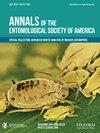Current Status of Five Warm Season Diptera Species in Estimating the Post-Mortem Interval
IF 1.8
3区 农林科学
Q1 ENTOMOLOGY
引用次数: 2
Abstract
Abstract The accurate estimation of the time of death (Post-Mortem Interval, PMI) is of great importance when reconstructing the actual events at a crime scene following the recovery of a body.The reliability of the PMI is vital to validate witness statements and suspect alibis.The PMI estimation based on insects collected from remains relies on two fundamental principles. Firstly, the development of an insect is proportionate to its surrounding environmental condition, and secondly, colonization by insects and other arthropods typically occur according to predictable sequences subjected to seasonality, environment in which the decomposition takes place, and the possible presence of xenobiotics in the food substrate (e.g., drugs). Dipteran species of the family Calliphoridae are the most common species colonizing a corpse and carcass, and a large body of research in entomology is focused on their developmental data. Such data is used forensically to estimate the PMI via three types of calculation: accumulated degree day/hour, table of growth, and isomegalen/isomorphen diagram. Much of this research has been documented during the 20th century, in different countries, using different experimental designs and analyses.This review tabulates development data obtained from 74 manuscripts published between 1933 and 2021 for five cosmopolitan blowfly species associated with the early stages of decomposition during the warmer seasons: Chrysomya megacephala, Ch. rufifacies, Ch. albiceps, Lucilia sericata, and L. cuprina. This review highlights the importance of establishing a standardized protocol to conduct future development studies and maintaining a system for retrieval of this data for future PMI calculations.五种暖季双翅目昆虫估计死后间隔的现状
摘要在尸体打捞后重建犯罪现场的实际事件时,准确估计死亡时间(死后间隔,PMI)非常重要。PMI的可靠性对于验证证人陈述和可疑不在场证明至关重要。基于从遗骸中采集的昆虫的PMI估计依赖于两个基本原则。首先,昆虫的发育与其周围环境条件成比例,其次,昆虫和其他节肢动物的定殖通常根据受季节性、分解发生的环境以及食物基质中可能存在的外源性物质(如药物)影响的可预测序列而发生。丽蝇科的双翅目物种是最常见的在尸体和尸体上定居的物种,昆虫学的大量研究都集中在它们的发育数据上。这些数据在法律上用于通过三种类型的计算来估计PMI:累计度日/小时、增长表和等值线图。这项研究的大部分都是在20世纪在不同的国家使用不同的实验设计和分析记录的。这篇综述列出了从1933年至2021年间发表的74篇手稿中获得的与温暖季节分解早期阶段有关的五种世界性飞蝇物种的发育数据:大头金蝇(Ch.rufiphases)、白蜡虫(Ch.albiceps)、绢毛绿蝇(Lucilia sericata)和铜蝇(L.cupina)。这篇综述强调了建立一个标准化协议以进行未来发展研究的重要性,并维护一个系统来检索这些数据以用于未来PMI计算。
本文章由计算机程序翻译,如有差异,请以英文原文为准。
求助全文
约1分钟内获得全文
求助全文
来源期刊
CiteScore
4.90
自引率
0.00%
发文量
25
审稿时长
6-12 weeks
期刊介绍:
The Annals of the Entomological Society of America exists to stimulate interdisciplinary dialogue across the entomological disciplines and to advance cooperative interaction among diverse groups of entomologists. It seeks to attract and publish cutting-edge research, reviews, collections of articles on a common topic of broad interest, and discussion of topics with national or international importance. We especially welcome articles covering developing areas of research, controversial issues or debate, and topics of importance to society. Manuscripts that are primarily reports of new species, methodology, pest management, or the biology of single species generally will be referred to other journals of the ESA. The most important criteria for acceptance are quality of work and breadth of interest to the readership.

 求助内容:
求助内容: 应助结果提醒方式:
应助结果提醒方式:


